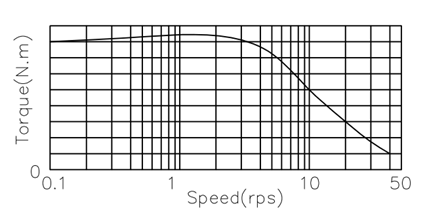Frequently, customers ask how much motor speed can reach of xxx model. Customers with this question generally is at the stage of model selection or product selection. For such issues, the following points could be your reference.
Firstly, you should understand one of the biggest features of stepping motor. It is the motor speed is adjustable. Also, the higher of the speed, the smaller of the pull-out torque. Please refer pic.1. In other meaning, how much the motor speed reaches is depending on load. Exactly, it depends on load torque TL, total rotor inertia ΣJ L and angle acceleration dw/dt.

Secondly, when select model, we can take reference of the motor Pull-out Torque-pulse curve and find the point where the motor needs to drive the load. By looking at the curve's corresponding speed rps and referring to the motor step angle, we can calculate the speed of the corresponding load point.
For the same size motor in the production, the slope of the Pull-out Torque-pulse curve can be adjusted. If you need to increase the corresponding load capacity at a certain speed, we only need to adjust the parameters of the winding. Two points must be explained: 1) the adjustable range is limited. If it is necessary to increase the load capacity at high speed (greater than 600 rpm) to more than 30%, servo motor is recommended; 2) If at the high speed point load capacity is increased, it will be reduced at low speed. If both need to be increased at the same time, a larger model should be used.
Fourthly, if in selecting motor, we suggest customers that firstly to make sure the speed and load requirement, then find the curve point which can satisfy the two requirements at the same time after calculating. The motor can be correspondingly confirmed. It is recommended to increase 30% margin when selecting motor model. And the specific formula is as follows:
TM ≥1.3*(TL+ΣJ L*dw/dt)
Note: 1. TM —The motor's pull-out torque N.m under the Speed V (rpm)
2. TL —Load torque N.m
3. ΣJ L —Total load rotor inertia K g.m2
4. dw/dt —angle acceleration rad/s
Source: CF Electric Motor Co., Ltd www.cfemotor.com
|